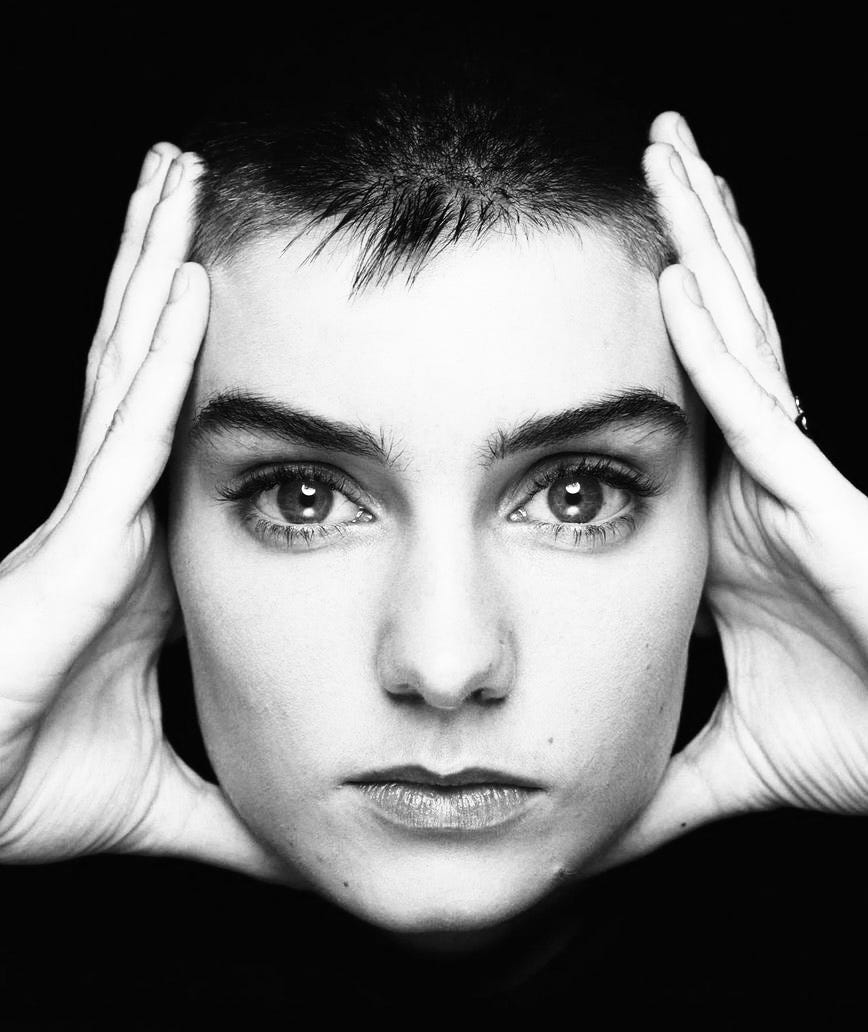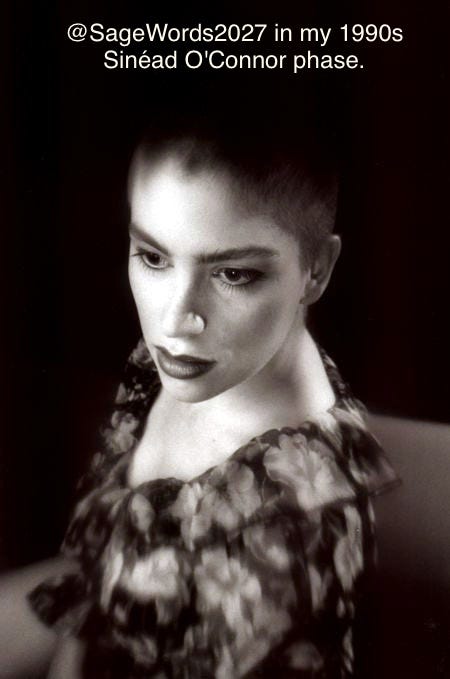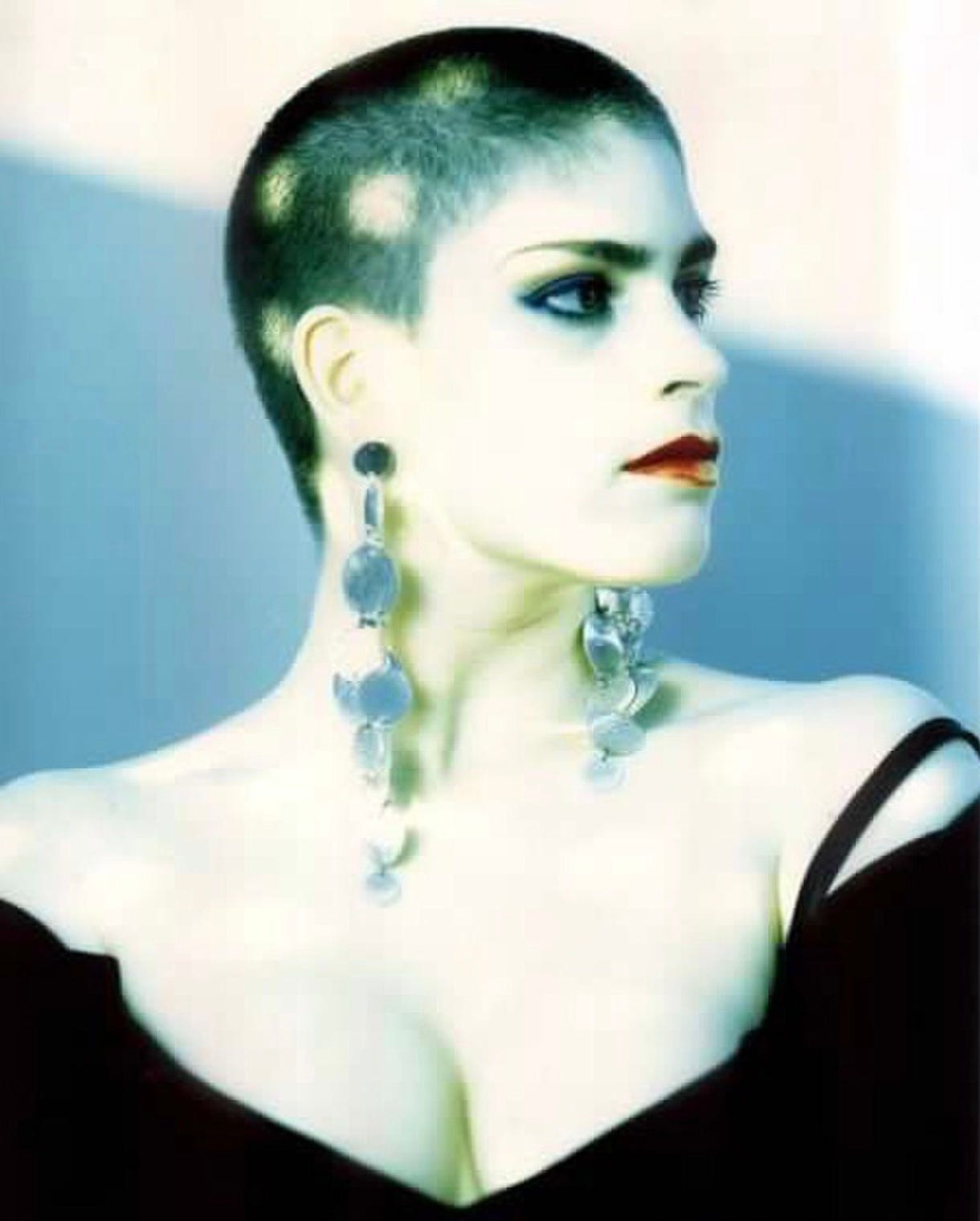In the documentary, Nothing Compares, Sinéad O'Connor said, “An artist’s job is to create the difficult conversations that need to be had, and it’s none of my business what anyone thinks of me when I do that.”
Sinéad O'Connor perfected the 1990s sound of rage filled whispers; her voice: a righteous scream of indignation, the crack of stepping on broken glass wrapped in velvet. In remembrance, many people will focus on her songs that provided a soundtrack to their lives or focus on her talent and originality as a vocalist and performing artist in remembering her career, which I too applaud; but for me, it was her bold and brave activism and courage to be her authentic self that planted seeds in my soul which are still sprouting today.
Sinéad O'Connor was ahead of her time by decades, in everything from her shaved head androgynous/nonbinary style to using her fame to be an advocate for others. In the early 1990s, I shaved my head like Sinéad, to be free of being defined by my hair (as well as having a severe allergic reaction to black hair dye). I traded in my long locks and formfitting clothing for a bald head, baggy jeans, and dashiki shirts. I wanted to be seen for who I was within or not at all. I thought that shaving my head and wearing oversized clothing might force people to look beyond my appearance and get to know me on a soul level. Unfortunately, people can only come to know us as deeply as they come to know themselves; and most people aren’t interested in knowing themselves very deeply. Self-awareness comes with responsibility and makes us more conscientious and therefore accountable for our thoughts, words, and deeds—which is why it’s often avoided through escapism. Instead of stripping my outward image so that people would see who I was within, I unintentionally created an appearance associated with being a skinhead or having cancer. Oof, best laid plans. Nevertheless, Sinéad and I were about the same build and age range; and with my shaved head, people often confused me for her. They’d call out, “Sinéad!” and snap my picture while driving in a brown Toyota Corolla; and I found it absurd. At one point, my husband and I were even chased by a group of girls in San Francisco yelling at me to “Go back home to Ireland, Sinéad!”
Many people, including professional peers, chanted that she should go home because she had refused to have the national anthem sung at her concert, as an act of protest against censorship in America. She repeatedly took many slings and arrows to support the black community, stating, “First of all, censorship shouldn’t happen at all to anybody; but secondly, I think that a lot of the time, there’s a lot of white artists who are very offensive as well, and they don’t get censored (for example, Andrew Dice Clay who was infamous at the time for his misogynistic “humor”), which leaves me thinking it’s a racist problem.” Sinéad was right, it was a racist problem; and she was one of the first white celebrities to call attention to it. Now, of course, white women have been silenced by cancel culture clap backs calling them “White Savior Barbie,” if they speak up and out against POC injustice. We should all speak up and continue to do so, no matter what names we’re called—cancel culture be damned!
In 1989, when Sinéad performed at the Grammy Awards, she had the Public Enemy group logo painted into her shaved head — showing her support for the group who boycotted the Grammys that year for not recognizing rap as a legitimate musical category. Before #blacklivesmatter was a hashtag, Sinéad O'Connor sang in the song, Black Boys on Mopeds, “It's the home of police who kill black boys on mopeds” about the crimes against black men. She saw the #discrimination done to others, and she used her platform to raise awareness.
Kris Kristofferson introduced her not by her beauty or talent, as precedes most females, but by what I consider the greatest compliment, a description of her character, saying, “Her name is synonymous with courage and integrity.”
Sinéad went on to boycott the Grammys, in 1991, to bring attention to the war in the gulf, saying, “It’s the creative community that are driven by greed. That’s why none of them are saying anything, because they’re afraid their careers are in jeopardy. That’s why nobody has said anything about the war.” (This is similar to our current climate, in which actors and writers are on strike against large streaming corporations and studios, which could have happened years before now if performers weren’t afraid of the consequences.) Imagine how many problems and inequities could be avoided if only more people with power spoke up and took a stand for what is right instead of spending their time with armchair activism posting lip service memes on social media.
Sinéad O'Connor stood in the empty spaces where justice should have been: speaking up and out against censorship, racism, child abuse, and reproductive freedom, which the press tried to use against her when she chose to give birth at a young age. When she was a teenager, she got pregnant, and her record company pressured her to get an abortion; but she chose instead to move to London and keep her baby. Later, when she was publicly vocal about supporting teenage girls who wanted to have an abortion and the interviewer tried to compare her situation to theirs, Sinéad swiftly corrected him and said, “No, it’s not the same. I had my baby when I was living in London, and I had enough money to get a nanny, and I had a boyfriend who was living with me, and I wasn’t in school. And I was in a society that doesn’t look down on pregnancy as much as Ireland does, so I don’t think you can compare that to a 15-year-old girl who has no money and no boyfriend and no support from anybody. I was in very nice circumstances compared to those girls.”
It took decades to prove she was right, after she accused the Catholic Church of protecting child molesters and shockingly ripped up the photo of the #pope on #SNL. If she hadn’t done that and brought public attention to the issue, how many more #children would have been #abused? She nearly lost her career to that brave act of social defiance. People were demonizing her as a person and destroying their copies of her music—going so far as to use a bulldozer so that her CDs couldn’t be resold. She was criticized with such vitriol because she interrupted the pattern of what is considered socially acceptable behavior. She made people uncomfortable because she pushed back, and she held up the mirror to society; and when people didn’t like what they saw in their own reflection, they took it out on her. She replied, “There’s no way I’m going to shut my mouth. I’m a battered child, and the whole bloody world is going to know about it—the same as they’re going to know about every other battered child. They are not going to be able to shut us up just because they don’t want to hear about it.”
What if we all had the courage to shine the light on abusers; how many people might we save? When one person rises up, it gives others the courage to do the same. When a group of people rise up, no one stands alone in the ridicule because there’s a resistance that builds from the power of shoulder-to-shoulder solidarity. That pushback actually creates a platform for change. Too often however, we view the one with courage as a target we don’t want to get too close to, in case we get hit ourselves. We point fingers and call them “crazy” for their courage, and we make them crazy through gaslighting and minimizing and dismissing them until they think they are the one with the problem. In reality, they are the truth teller, the way-shower, the bold, vulnerable human who is shining the solution by walking the talk. It’s our job to link arms and join them, instead of standing on the sidelines, talking smack, creating crippling self-doubt, and labeling them as mentally ill. In response to all the haters, Sinéad wrote an open letter in The Irish Times in 1993.
“My name is Sinéad O’Conner. I’m learning to love myself. I am deserving. I deserve to be treated with respect. I deserve not to be treated like dirt. I deserve to be listened to. My name is Sinéad O’Conner. I am a woman. I have something to offer. I am and have always been carrying a lot of grief: from my lost childhood and for the effects of its horror and violence on my life. I find it hard to be myself, to show my feelings, to get to the joy. I need to release the pain, which is blocking me. If I do not do this, I will not survive. I was angry before because I was frightened; but I know that if you could really listen, you’d see that we do not know what we are doing when we mock the expression of human feeling. When we scoff at the sound of our children’s keening, there is a mirror into which we are not looking.”
Sometimes, Sinéad was dismissed and labeled as having a mental illness, the result of having survived childhood trauma and public ridicule. The real mental illness in society, however, is our collective inability to look in the mirror—it’s our obsession with escapism and a lack of accountability and brave, bold action, something Sinéad O’Conner had in spades.
When the cacophony of social criticism tried to make her small, she stood her ground and sang, “Until the philosophy
Which hold one race superior and another
Inferior
Is finally
And permanently
Discredited
And abandoned
Everywhere is war”
This word, “war” was used to describe taking a stand for what we believe in. Not every war is fought with weapons in uniform. The greatest battles are within and call for us to each act with integrity.
When Sinéad was booed while on a stage for a Bob Dylan concert, for having the #courage to stand up for what she believed was right, only one person stopped what they were doing and stood beside her, Kris Kristofferson.
Let her life #inspire us all to #listen to the #women who have the #courage to speak the #truth and do the #right thing. Stand with the person who rises, instead of knocking them down or turning your back on them. #history has a way of proving they were right, and they deserved our support when they were #alive and could have used it.
Rest in power, #sineadoconnor
Sage Justice is achingly sincere. Balancing wisdom and humor she most often writes deeply personal solution based pieces about the enduring virtues that connect us all: love and healing. She is an award-winning playwright and critically acclaimed performing artist who has appeared on stages from Madison Square Garden in New York City, to The Comedy Store in Hollywood, California. Ms. Justice is the author of Sage Words FREEDOM Book One, an activist, a member of the Screen Actors Guild and an alumna Artist-In-Residence of Chateau Orquevaux, France. She is a co-founder of The Unity Project which fuses activism with art, to educate and inspire, with a special emphasis on community engagement to end homelessness. She has a series of short reels about living with the rare genetic disorder, Vascular Ehlers-Danlos Syndrome that you can find in a highlight reel on her Instagram page @SageWords2027.
SAG-AFTRA & WRITERS GUILD STRIKE—My husband and I are both working professionals in the entertainment industry and our income is being directly impacted by the Writers and Actor’s Guild Strike. If you’ve found value in my essays on conflict resolution, relationship dynamics, peaceful parenting, or the seven-piece series I’ve written on PRIDE, the four-part series on how to end mass shootings, or the five-part series on protecting children and reproductive freedom would you please consider a paid subscription to SageJustice.Substack.com for yourself and for a friend? A monthly subscription is just $5 a month, a yearly subscription is $45. Writers provide a much-needed service to the community. We gather information and turn it into inspiration, education and understanding to bring people together and solve universal challenges; and right now, we need your financial support. Thank you.
Sage Justice is the author of “Sage Words FREEDOM Book One.”






